Without truly understanding customer experience (CX), making informed decisions that lead to customer loyalty and business success is nearly impossible. The most effective, high-integrity way to gather this understanding? By asking your customers directly.
Through well-designed customer experience surveys, you can collect focused, valuable data about customer interactions with your product, service, or brand.
In this guide, we will elevate your approach by defining a customer experience survey and explaining the six strategic reasons to deploy one. Crucially, we will provide a comprehensive list of 15 essential cx survey questions, categorized by the metric they measure. Finally, you will learn proven strategies for survey creation and access a customer satisfaction survey template free of charge.
First things first: What is a customer experience survey?
A customer experience survey is a valuable tool that helps you evaluate customers’ experiences with your brand, products, or services.
Its primary purpose is to learn what your customers think about your brand, products, or services. You can ask questions for many purposes, from assessing customer satisfaction levels to identifying their challenges.
6 Strategic reasons to use an online CX survey (The ROI of asking)
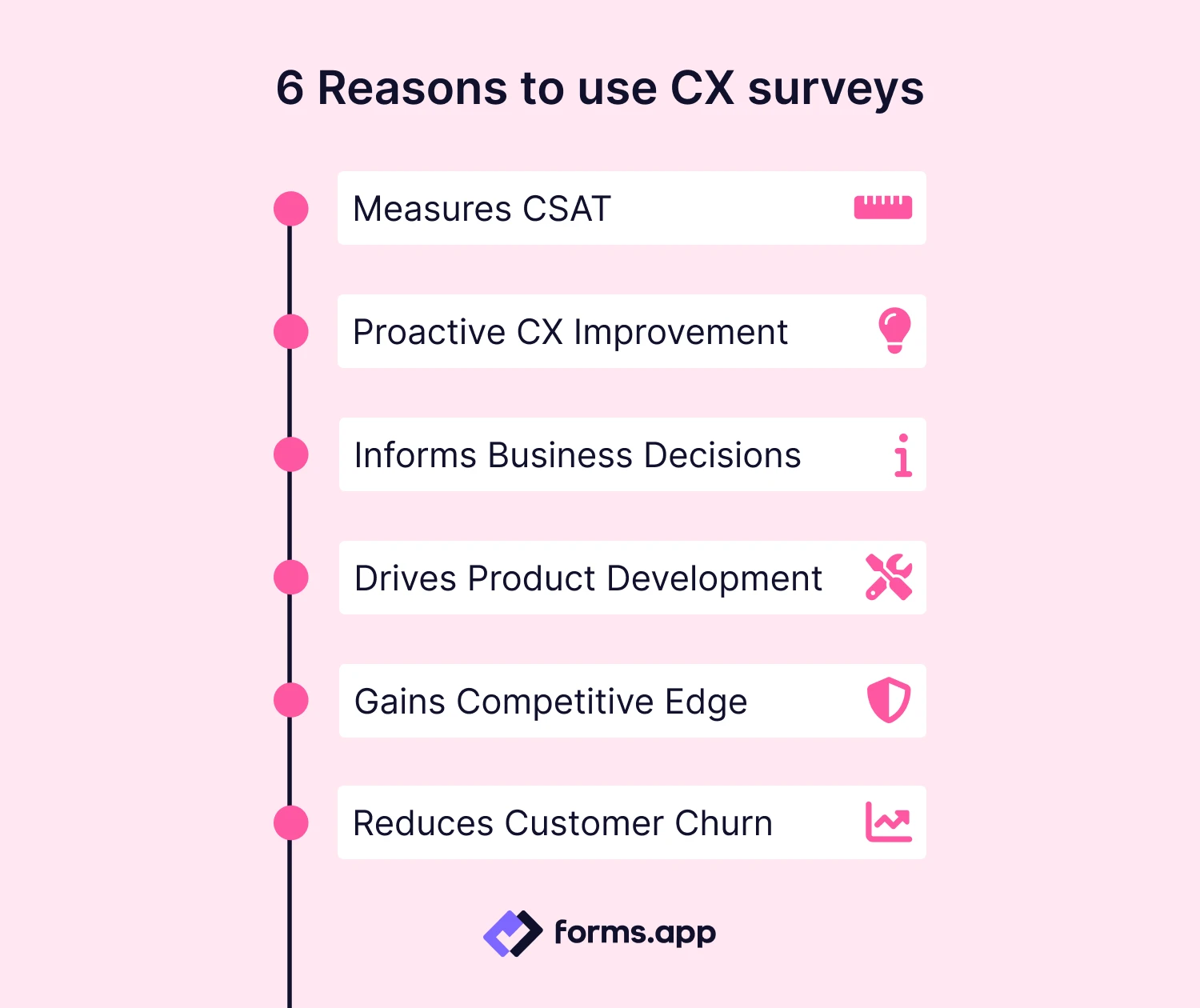
Reasons to use CX surveys
Creating a customer experience survey has many advantages in real-time data collection about customer experience. Compared to traditional survey tools, these surveys help you collect customer feedback while their experience is still fresh. You can see below some detailed reasons why you should create a customer experience survey for your business:
🚀 Provides valuable insights into customer satisfaction
Surveys deliver measurable, trackable data that goes beyond a simple purchase history. They allow you to benchmark satisfaction levels accurately and monitor trends over time. If you are looking for effective ways to increase customer satisfaction, our article on collecting customer complaints may be helpful.
💡 Enables improving the customer experience
Well-crafted cx survey questions help you pinpoint customer expectations and experience gaps across all domains (product, sales, support). This insight allows you to deliver a more streamlined and unified customer experience.
📊 Benefits your informed business decision-making process
Customer experience surveys transform qualitative comments into quantitative data, enabling you to manage investments, prioritize feature development, and allocate resources more consciously and effectively.
🛠️ Provides customer-based product or service development
By asking about pain points and feature requests, you gain detailed stories that help you run a customer-based product or service development process, ensuring your roadmap meets real user needs.
🛡️ Helps you gain a competitive advantage
Understanding customer preferences and frustrations better than your competitors allows you to quickly adjust your offerings, ensuring you are always one step ahead in delivering perceived value.
📉 Helps you minimize customer churn
Surveys, especially those deployed at critical interaction points, act as an early warning system. By identifying unhappy customers immediately, you can proactively intervene to prevent churn and foster long-term loyalty. You can also use customer retention statistics that can help you prevent customer churn and increase retention rates.
15+ Essential customer experience survey questions
To demonstrate maximum expertise and extract the most valuable data, you should structure your customer survey examples around specific, universally recognized CX metrics.
1. How likely are you to recommend us to a friend or colleague?
This is the gold standard for measuring loyalty and brand advocacy. The feedback reveals who is likely to be a "Promoter" (9-10), a "Passive" (7-8), or a "Detractor" (0-6).
2. How satisfied are you with our product or service overall?
Measures the customer's general, high-level happiness. An essential benchmark for overall sentiment and brand perception.
3. Thinking about the time it took to resolve your issue, how satisfied were you?
This variant specifically measures satisfaction with service efficiency and speed, a critical factor in the overall experience.
💡 You can check our net promoter score (NPS) template.
4. How easy was it to complete your purchase/resolve your issue today?
This measures friction. Low effort correlates directly with loyalty. High effort reveals critical process blockers in your user journey.
5. How satisfied were you with your experience with our customer service team?
A baseline check immediately after a service interaction. Measures the perceived success of the support interaction.
6. Thinking about your recent interaction, how well did our agent understand your specific issue?
This provides direct customer service feedback examples on staff training and competence, identifying gaps in knowledge or listening skills.
7. What is the one thing the representative could have done to make your experience better?
A crucial question for gathering specific, actionable customer service feedback examples that can be used for coaching and policy improvements.
8. How easy was it to use our product/service to achieve your goal?
Measures product friction. Low scores indicate a need for UX/UI improvements or clearer documentation.
9. What features of our products and services do you find most valuable?
Helps determine which features drive retention and justify pricing. Use the results to guide marketing and development efforts.
10. What do you think we need to improve about our product or service?
Directly asks for input on weaknesses (e.g., product quality, shipping times, or pricing), guiding your improvement backlog.
11. Did our product/service ultimately solve the problem you were trying to address?
Evaluates core product functionality and whether it delivers on the essential promises made to the customer.
12. How would you rate your experience with our brand overall?
Focuses on the emotional connection and overall perception, which is separate from satisfaction with a single product.
13. What do you think about our product/service pricing?
Evaluates the perceived value of your offerings relative to the cost. Helps you gauge pricing fairness and market positioning.
14. How likely are you to choose us for your next purchase?
Measures purchase intent and is a strong predictor of customer loyalty and future sales potential.
15. Do you have any other comments or suggestions about your experience that you want to share with us?
The essential safety net question allows customers to share concerns that may not have been covered by the quantitative questions.
💡 You can also use customer service survey example questions or customer service feedback examples to more comprehensively evaluate customer experiences with your services.
Mastering Customer Experience Survey Best Practices: The DOs & DON’Ts
To ensure your data is accurate and your response rates are high, follow these customer experience survey best practices.
Dos:
✔️ Make your survey purpose clear: Setting clear goals for your survey will help you increase participation and get more accurate results.
✔️ Thank customers: Adding an ending message like “Thank you for your time! We appreciate your feedback” at the end of the survey will make your customers feel more valued and help strengthen their emotional connection to your brand. As another indicator that you value your customers, you can take the necessary precautions by using customer service statistics.
✔️ Repeat your survey regularly: Repeating your survey regularly to understand customer expectations and market dynamics will help you keep up with changing customer needs.
✔️ Make your survey mobile-friendly: With the widespread use of technology, the access rate to surveys via mobile devices has also increased significantly, so you can increase participation by making your survey mobile-compatible.
✔️ Benefit from customer experience survey best practices: You can use customer experience survey best practices to achieve effective results regarding your survey's design and content.
✔️ Check out customer feedback statistics: In addition to your own survey results, it's also helpful to look at customer feedback statistics that provide valuable insights into customer experience.
Don’ts:
❌ Avoid long and complicated questions: Long and complex questions can both decrease response rates and sometimes cause misunderstandings. Instead, by asking short and clear questions, you can both increase participation and get more accurate answers.
❌ Do not ask for unnecessary personal information: Customers can often be concerned about trust when you ask for personal information, or may avoid giving honest answers. Therefore, you can increase participation by not including questions that include personal information in your survey and ensuring anonymity.
❌ Do not include leading and biased questions: Another factor that can cause you to get wrong results is to include leading questions. You can get more honest and unbiased results by avoiding leading questions as much as possible.
How can I create my own customer experience survey with forms.app?
Creating a customer experience survey that collects rich, actionable data is vital. Instead of starting from scratch, you can use our professionally designed template to guide your setup and question selection.
Step 1: Log in or sign up for forms.app

Open your forms.app account
The first step to creating a survey in the forms.app is to log in or sign up. You can create an account in seconds if you don't have one. You can create your client experience survey directly by going on the platform if you already have an account. The forms.app also lets you use your Google or Apple accounts to make logging in easy.
Step 2: Start with a blank form, choose a template, or generate with AI
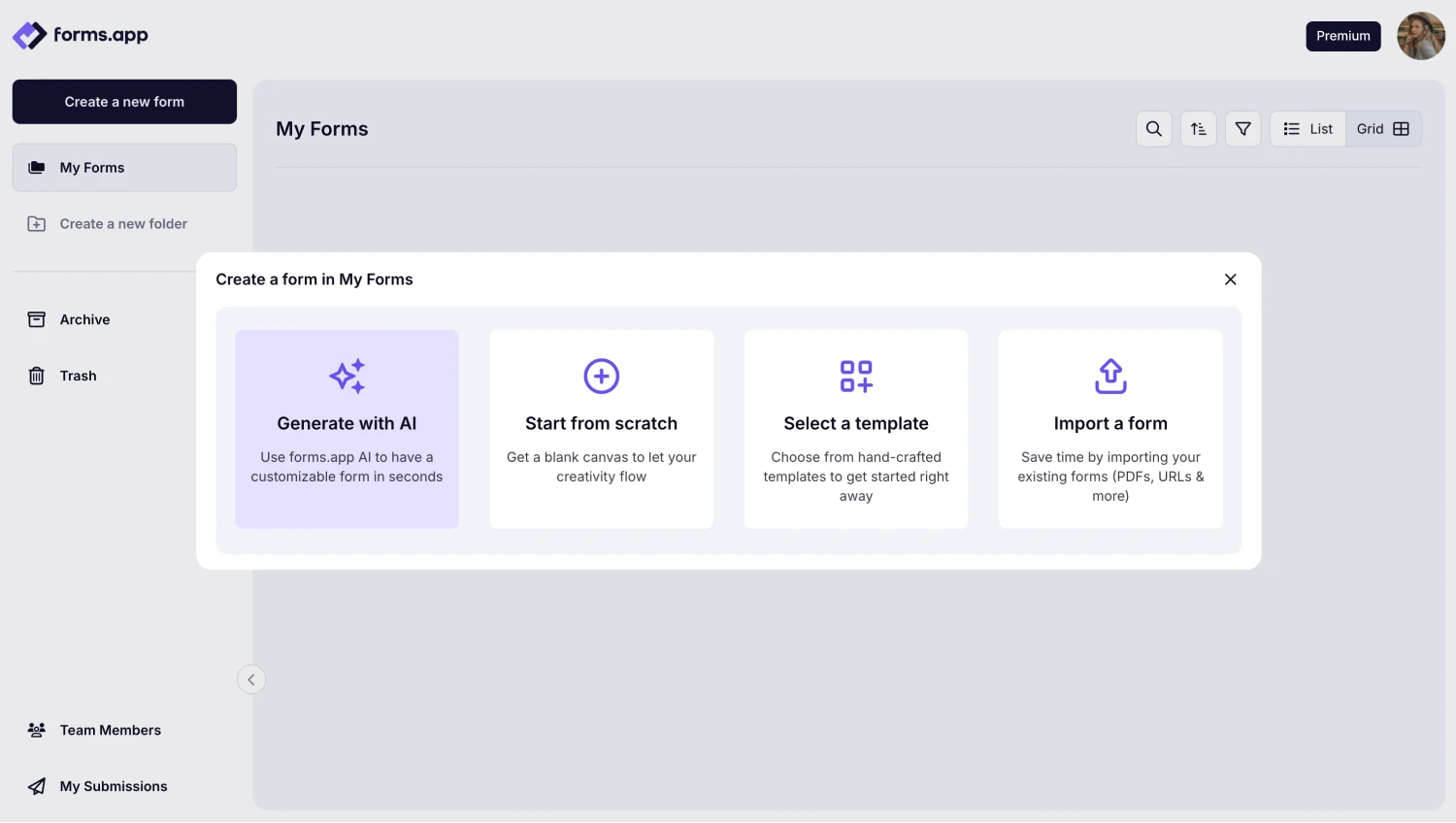
Choose a way to start
Once logged in, find the option to “create form” and create a new customer experience survey. Also, ready-made feedback form templates in forms.app. You can also easily edit and change these customer survey examples to suit your goals and wishes. In this step, you can use customer satisfaction survey templates for free or customer feedback surveys to collect customer feedback.
💡 In addition to this, you can also get help from forms.app AI survey tool to create your survey.
Step 3: Add your questions
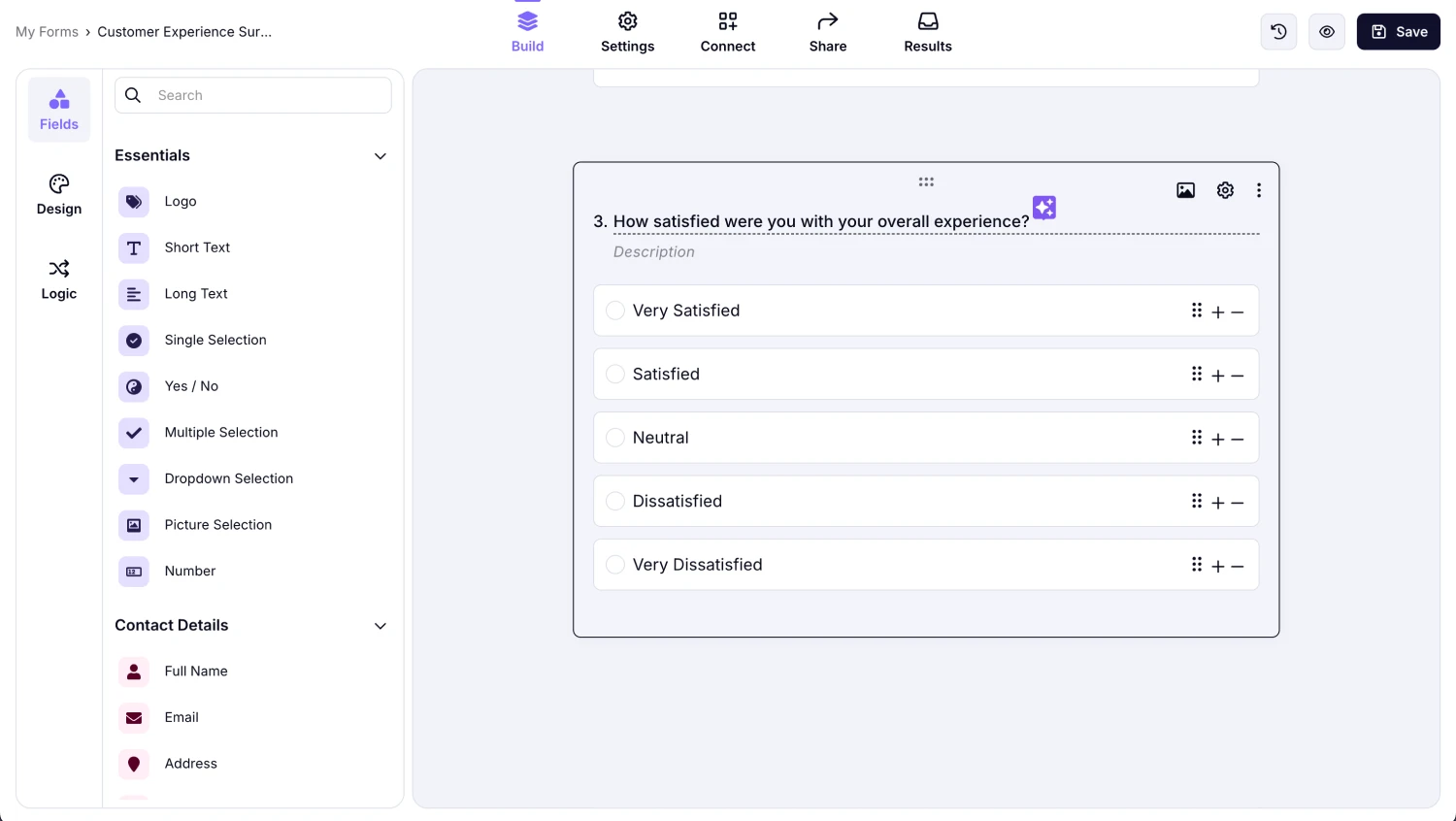
Add questions and fields
After choosing a suitable template, you can add your customer experience survey questions according to your goals. In addition to the questions for customer experience evaluation we have prepared for you above, for the teacher feedback form for students or parents, you can also benefit from SaaS customer survey questions that can have similar content.
forms.app offers a variety of question types, including multiple-choice questions, short answers, open-ended, and closed-ended. Combining question types helps you better understand your customers' feelings and increases response rates.
Step 4: Customize your survey design
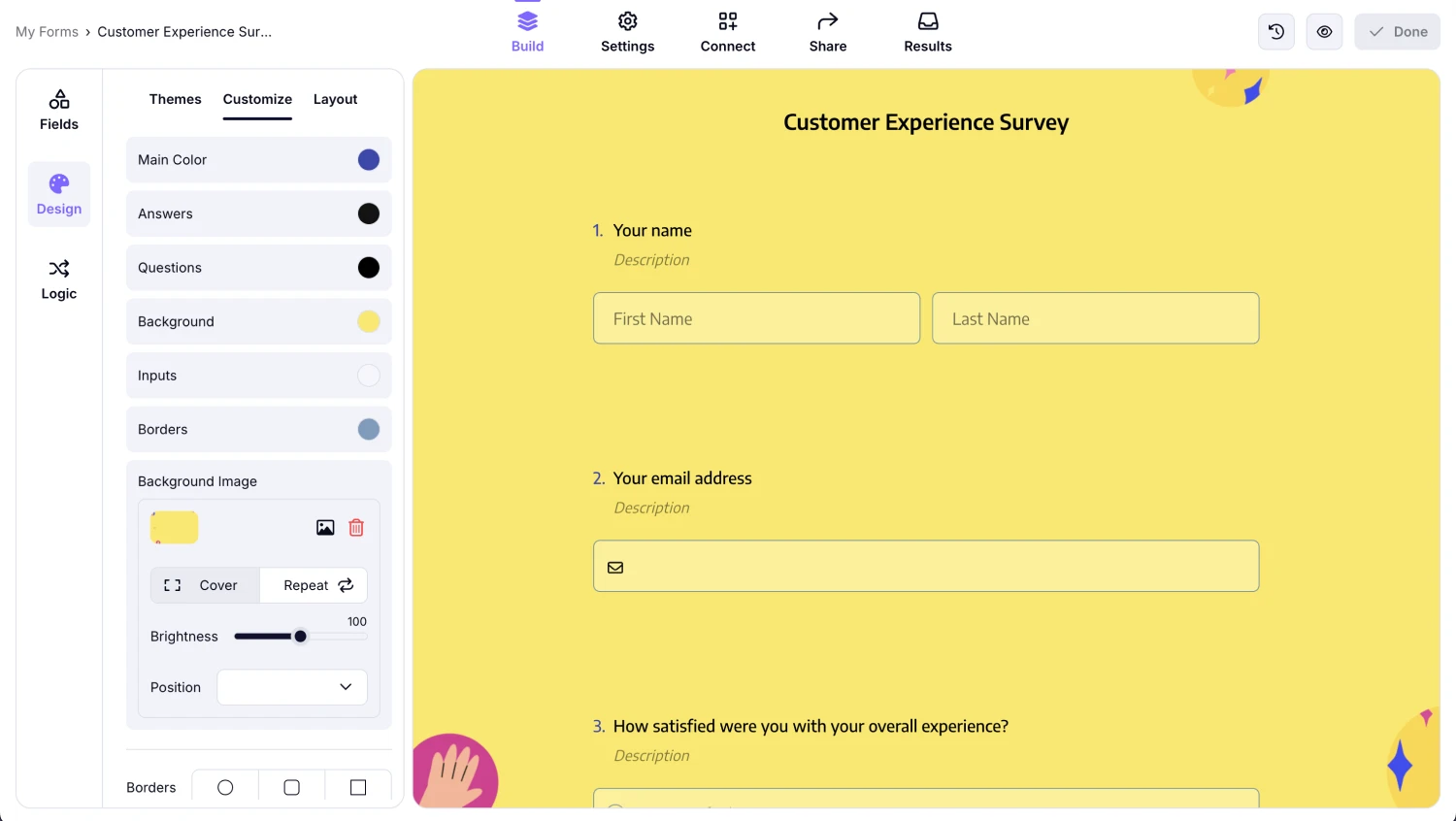
Style your survey
You can style your survey easily through the design field. You can easily select a theme and change colors. Additionally, you can choose a new background image and a view type. You can tailor colors, fonts, and other overall design tools to create a form that mirrors your organization's identity.
💡 Editor’s experience: Adding your company’s logo and cover will make the survey more professional.
Step 5: Share your survey
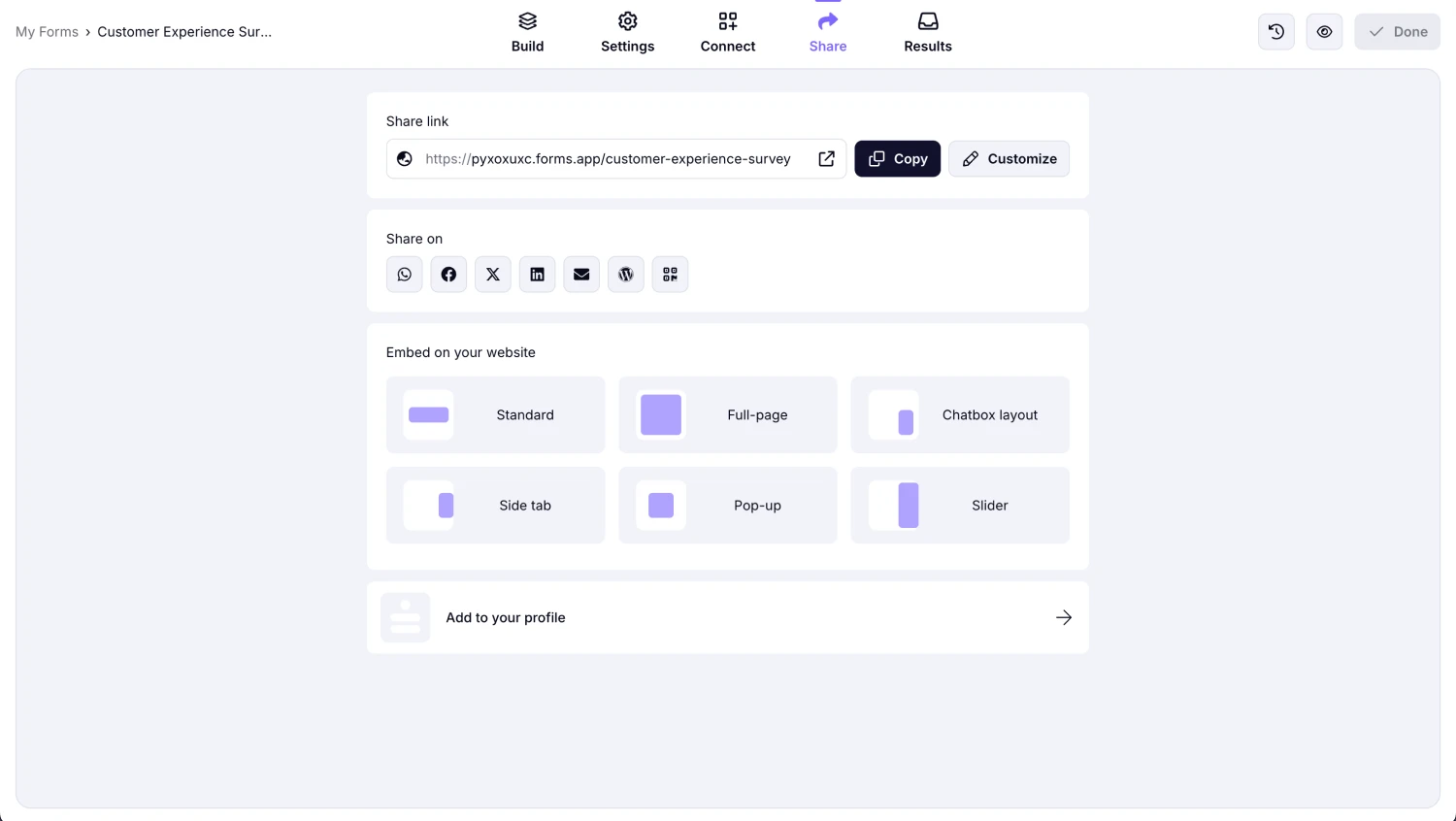
Share your survey
You can share your survey form with your target audience using various sharing options within the forms.app. Also, utilize various sharing options provided by the forms.app. You can share your survey on popular social media platforms like Facebook, Twitter, LinkedIn, and WhatsApp. Additionally, you can embed your survey on your website and generate QR codes for easy access.
Step 6: Analyze your survey results
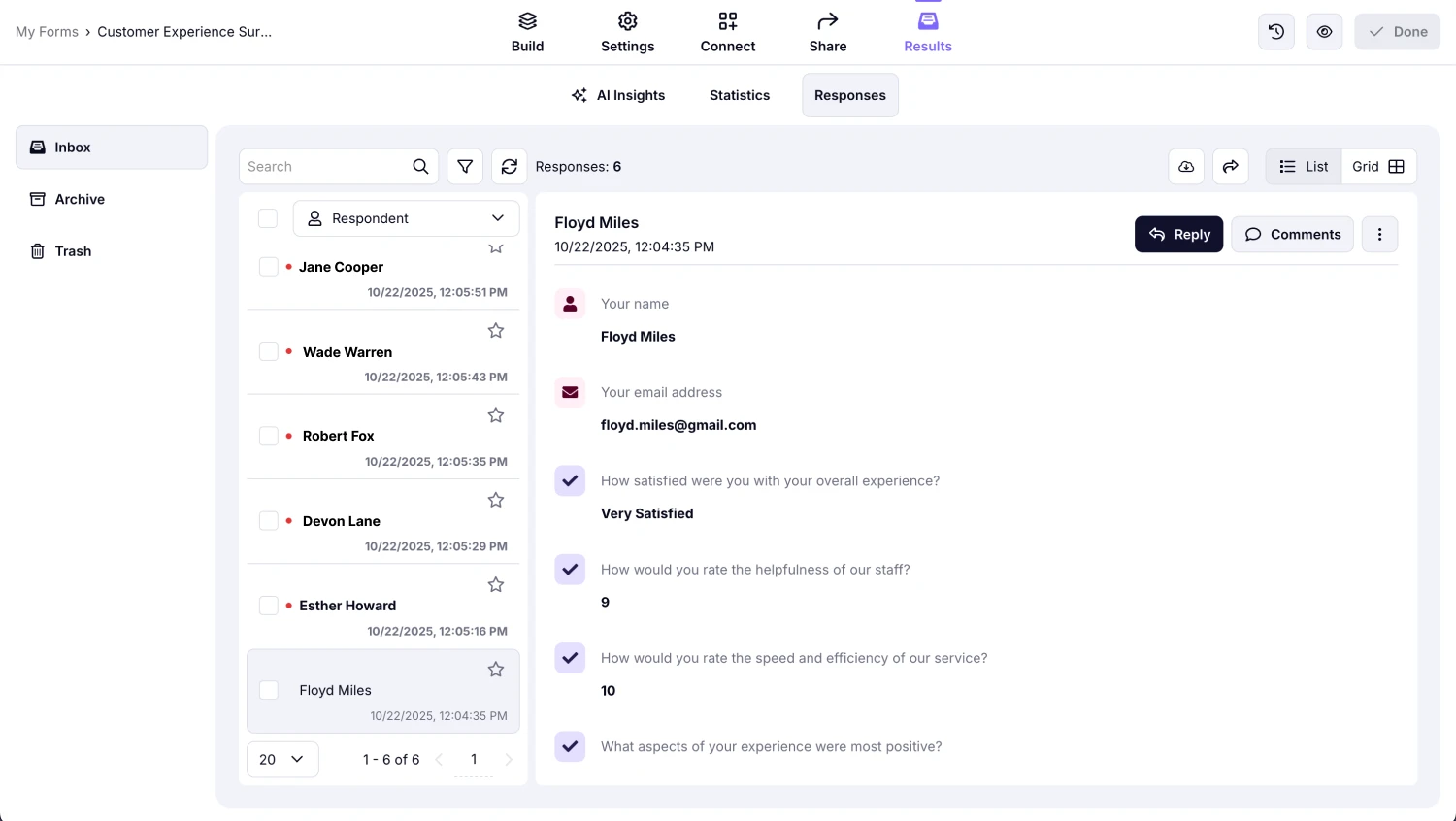
Analyze the survey results
Analyzing the survey results will help craft a marketing strategy that aligns with customer expectations. With forms.app, you can also automatically analyze the data you collect online without a data or file upload process. forms.app offers features and filters to analyze their responses. Also, don't forget to share feedback and improvements that can be made to make your customers feel more valued.
💡 Editor’s experience: Using AI Insights helped me a lot to see the big picture, especially if you have collected lots of data.
Wrapping it up
Positive customer experiences are the engine of business success. If you provide a good experience, your customers will remain loyal, act as natural advocates, and ultimately drive higher conversion rates and sales.
By creating a structured, metric-driven client experience survey and implementing these customer experience survey best practices, you are positioning your business to not only react to feedback but to anticipate customer needs.
Review your current surveys against our 15 essential cx survey questions list today, and don't forget to leverage the customer satisfaction survey template free of charge to streamline your data collection process.
- First things first: What is a customer experience survey?
- 6 Strategic reasons to use an online CX survey (The ROI of asking)
- 15+ Essential customer experience survey questions
- Mastering Customer Experience Survey Best Practices: The DOs & DON’Ts
- How can I create my own customer experience survey with forms.app?
- Wrapping it up
forms.app, your free form builder
- Unlimited views
- Unlimited questions
- Unlimited notifications




